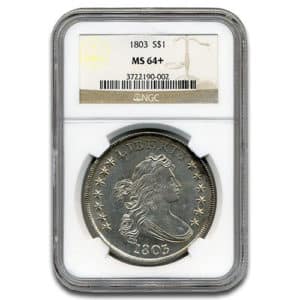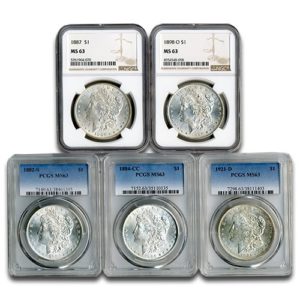$325,000.00
1803 DRAPED BUST $1- LARGE 3 VARIETY
NGC MS64+
The Draped Bust dollar obverse was designed by noted artist Gilbert Stuart in an attempt to elevate U.S. coinage designs to 'world class' stature. Large Eagle Bust dollars were minted from 1798 through 1803. The model is also unknown, though Ann Willing Bingham has been suggested. Ann Willing Bingham at 21, sketch by Gilbert Stuart, 1785. Ten years later he created the image that U.S. Mint engraver Robert Scot used for his engraving of Liberty on the Draped Bust coins. The previous Flowing hair issue represented a 'young' Liberty obverse, and a young hatchling eagle on the reverse. This Draped Bust design featured a more 'matronly' maturing Liberty, with an older and more naturalistic heraldic eagle, as an adaptation of the Great Seal of the United States. One oversight in the iconography of the Heraldic Eagle reverse, though, was in the placement of the arrows in the eagle's right claw? the more honorable placement in heraldry, leaving the olive branch in the left or less honorable claw. This more warlike placement of the arrows was repeated on all heraldic eagle coins of the period. This reverse continued through 1803, until it was resurrected in 1834 to make the exceedingly rare 1804 silver dollar. The 1803 dollar was the last circulating dollar for 33 years, until the Gobrecht dollar was introduced in 1836.
In 1803, silver dollars began to disappear from circulation, and many U.S. dollars were shipped overseas or melted for their high intrinsic value. In later years, ''restrike'' pieces were produced dated 1804 as were Proof restrikes from new dies bearing the dates 1801, 1802 and 1803. Among business strikes, examples most often encountered are apt to be dated 1798 or 1799. Those dated 1800 are scarcer, while those dated from 1801 to 1803 are rare. With a mintage of only 85,634 pieces, there were a two major varieties of the 1803 Draped Bust Silver Dollar. Both varieties deal with the sizing and styling of the number ''3'' in the 1803 date. Each has a different style ''3'' but one variety has a larger digit while the other has a smaller digit. The large 3 also has a vertical serif on the top bar of the '3' (top-left portion of the ''3'') while the small 3 doesn't. The large 3 is the rarer of the two issues. Today, there are approximately just 3,200 surviving pieces in all grades. Grades found usually range from Very Good through Very Fine. Extremely Fine and AU coins are very scarce. Strictly Uncirculated coins are rather rare, and higher Mint State such as the present are exceedingly rare.
1803 Draped Bust dollars are scarce coins in every respect, with a low mintage and far fewer survivors left for collectors who desire these historic pieces of early U.S. Mint history. The Draped Bust dollar is undeniably a popular early American coin series that is historically significant, and commands high premiums in Mint State grades? Such coins are quite elusive today and usually don't last long when offered for sale. Over the two centuries since their manufacture, the short-lived series of Draped Bust dollars has continued to be one of the most widely collected in U.S. coinage because of their rarity, beauty, popularity and historical significance.
No MS64+ has been presented at public auction. Worthy of note is a NGC MS65+ selling at auction in November 2013 for $705,000. The current Price Guide at NGC lists the MS64+ for $400,000, and PCGS lists it at $350,000. Don't miss this opportunity to add a world class rarity to your collection at a condition that will satisfy the most discriminating connoisseur.
In stock














Reviews
There are no reviews yet.